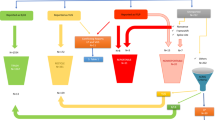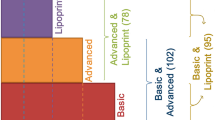Abstract
Whole-exome sequencing allows for an unbiased and comprehensive mutation screening. Although successfully used to facilitate the diagnosis of single-gene disorders, the genetic cause(s) of a substantial proportion of presumed monogenic diseases remain to be identified. We used whole-exome sequencing to examine offspring from a consanguineous marriage featuring a novel combination of congenital hypothyroidism, hypomagnesemia and hypercholesterolemia. Rather than identifying one causative variant, we report the first instance in which three independent autosomal-recessive single-gene disorders were identified in one patient. Together, the causal variants give rise to a blended and seemingly novel phenotype: we experimentally characterized a novel splice variant in the thyroglobulin gene (c.638+5G>A), resulting in skipping of exon 5, and detected a pathogenic splice variant in the magnesium transporter gene TRPM6 (c.2667+1G>A), causing familial hypomagnesemia. Based on the third variant, a stop variant in ABCG5 (p.(Arg446*)), we established a diagnosis of sitosterolemia, confirmed by elevated blood plant sterol levels and successfully initiated targeted lipid-lowering treatment. We propose that blended phenotypes resulting from several concomitant single-gene disorders in the same patient likely account for a proportion of presumed monogenic disorders of currently unknown cause and contribute to variable genotype-phenotype correlations.
Similar content being viewed by others
Log in or create a free account to read this content
Gain free access to this article, as well as selected content from this journal and more on nature.com
or
References
Biesecker LG, Green RC : Diagnostic clinical genome and exome sequencing. N Engl J Med 2014; 370: 2418–2425.
Boycott KM, Vanstone MR, Bulman DE, MacKenzie AE : Rare-disease genetics in the era of next-generation sequencing: discovery to translation. Nat Rev Genet 2013; 14: 681–691.
Bamshad MJ, Ng SB, Bigham AW et al: Exome sequencing as a tool for Mendelian disease gene discovery. Nat Rev Genet 2011; 12: 745–755.
Yang Y, Muzny DM, Reid JG et al: Clinical whole-exome sequencing for the diagnosis of mendelian disorders. N Engl J Med 2013; 369: 1502–1511.
Yang Y, Muzny DM, Xia F et al: Molecular findings among patients referred for clinical whole-exome sequencing. JAMA 2014; 312: 1870–1879.
Sheridan E, Wright J, Small N et al: Risk factors for congenital anomaly in a multiethnic birth cohort: an analysis of the Born in Bradford study. Lancet 2013; 382: 1350–1359.
Lausch E, Janecke A, Bros M et al: Genetic deficiency of tartrate-resistant acid phosphatase associated with skeletal dysplasia, cerebral calcifications and autoimmunity. Nat Genet 2011; 43: 132–137.
Kamphans T, Krawitz PM : GeneTalk: an expert exchange platform for assessing rare sequence variants in personal genomes. Bioinformatics 2012; 28: 2515–2516.
Seelow D, Schuelke M : HomozygosityMapper2012–bridging the gap between homozygosity mapping and deep sequencing. Nucleic Acids Res 2012; 40: W516–W520.
Mackay DS, Jones PJ, Myrie SB, Plat J, Lutjohann D : Methodological considerations for the harmonization of non-cholesterol sterol bio-analysis. J Chromatogr B Analyt Technol Biomed Life Sci 2014; 957: 116–122.
Schlingmann KP, Weber S, Peters M et al: Hypomagnesemia with secondary hypocalcemia is caused by mutations in TRPM6, a new member of the TRPM gene family. Nat Genet 2002; 31: 166–170.
Schlingmann KP, Sassen MC, Weber S et al: Novel TRPM6 mutations in 21 families with primary hypomagnesemia and secondary hypocalcemia. J Am Soc Nephrol 2005; 16: 3061–3069.
Mannucci L, Guardamagna O, Bertucci P et al: Beta-sitosterolaemia: a new nonsense mutation in the ABCG5 gene. Eur J Clin Invest 2007; 37: 997–1000.
Xiong HY, Alipanahi B, Lee LJ et al: RNA splicing. The human splicing code reveals new insights into the genetic determinants of disease. Science 2015; 347: 1254806.
Targovnik HM, Citterio CE, Rivolta CM : Thyroglobulin gene mutations in congenital hypothyroidism. Horm Res Paediatr 2011; 75: 311–321.
Targovnik HM, Edouard T, Varela V et al: Two novel mutations in the thyroglobulin gene as cause of congenital hypothyroidism: identification a cryptic donor splice site in the exon 19. Mol Cell Endocrinol 2012; 348: 313–321.
Alzahrani AS, Baitei EY, Zou M, Shi Y : Clinical case seminar: metastatic follicular thyroid carcinoma arising from congenital goiter as a result of a novel splice donor site mutation in the thyroglobulin gene. J Clin Endocrinol Metab 2006; 91: 740–746.
Ng SB, Buckingham KJ, Lee C et al: Exome sequencing identifies the cause of a mendelian disorder. Nat Genet 2010; 42: 30–35.
Roach JC, Glusman G, Smit AF et al: Analysis of genetic inheritance in a family quartet by whole-genome sequencing. Science 2010; 328: 636–639.
Makrythanasis P, Nelis M, Santoni FA et al: Diagnostic exome sequencing to elucidate the genetic basis of likely recessive disorders in consanguineous families. Hum Mutat 2014; 35: 1203–1210.
Hansel B, Carrie A, Brun-Druc N et al: Premature atherosclerosis is not systematic in phytosterolemic patients: severe hypercholesterolemia as a confounding factor in five subjects. Atherosclerosis 2014; 234: 162–168.
Valencia CA, Husami A, Holle J et al: Clinical impact and cost-effectiveness of whole exome sequencing as a diagnostic tool: a pediatric center's experience. Front Pediatr 2015; 3: 67.
Sawyer SL, Hartley T, Dyment DA et al: Utility of whole-exome sequencing for those near the end of the diagnostic odyssey: time to address gaps in care. Clin Genet 2015, e-pub ahead of print 18 August 2015 doi:10.1111/cge.12654.
Acknowledgements
YL and AK were funded by the Emmy Noether Programme of the German Research Foundation (KO 3598/2–1). EL and BZ are supported by national and EU-funded Rare Disease Network Programmes FACE (agreement no. 01GM1109A, TP1); SYBIL (FP7 grant agreement no. 602300) and INTERREG IV project A27 to EL. The work of AK and EL was additionally funded through the German Research Foundation (CRC 1140). We thank Anja Kerksiek for excellent technical assistance. We thank the patients and their family members for the participation in this study.
Author information
Authors and Affiliations
Corresponding authors
Ethics declarations
Competing interests
The authors declare no conflict of interest.
Additional information
Supplementary Information accompanies this paper on European Journal of Human Genetics website
Supplementary information
Rights and permissions
About this article
Cite this article
Li, Y., Salfelder, A., Schwab, K. et al. Against all odds: blended phenotypes of three single-gene defects. Eur J Hum Genet 24, 1274–1279 (2016). https://doi.org/10.1038/ejhg.2015.285
Received:
Revised:
Accepted:
Published:
Issue date:
DOI: https://doi.org/10.1038/ejhg.2015.285
This article is cited by
-
OligoPVP: Phenotype-driven analysis of individual genomic information to prioritize oligogenic disease variants
Scientific Reports (2018)
-
Analysis of exome data for 4293 trios suggests GPI-anchor biogenesis defects are a rare cause of developmental disorders
European Journal of Human Genetics (2017)
-
A Clinician’s perspective on clinical exome sequencing
Human Genetics (2016)



